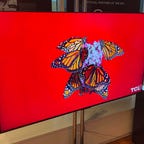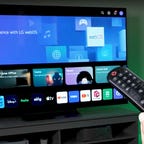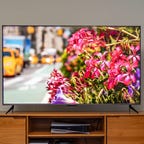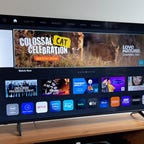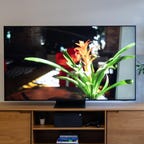CNET's Top Picks for 75-Inch TVs in 2024
Want a massive TV to binge all your favorite shows? Check out our favorite 75-inch and 77-inch TVs.
Our Picks
The most important factor when choosing a new TV is its size, and that depends on your room type and how far from the wall your sofa or bed is located. At CNET, our general advice is that bigger is usually better, especially if you're looking to get the most bang for your buck. To help you find the right big-screen TV for your needs and budget, we've rounded up some of the best 75-inch TVs on the market right now.
The list below represents the best TVs I've reviewed in CNET's test lab, where I've compared them side by side. I've actually reviewed the 65-inch sizes in the series for most of the models listed below, but the 75- and 77-inch versions are basically identical beyond screen size.
What is the best 75-inch TV right now?
The TCL QM8 TV sits at the top of our list of best TVs for a number of reasons. It offers superb picture quality, an affordable price tag and Roku, the best smart TV system. It also includes gaming features like 4K/120Hz input and variable refresh rate that can get the most out of consoles like the PS5 and Xbox Series X. When a friend asks me what 65- to 98-inch TV to buy, and money is still an object, I tell them to get the TCL QM8.
There are plenty of other excellent choices out there, however, so even though the QM8 is my current favorite for most people, it might not be right for your preferences or budget.
Best 75-inch TVs of 2024
TCL has topped our list of the best TVs for the last few years but the QM8 is something different, and even better than before. In my comparison tests, it stood out with superior brightness and impact while still maintaining excellent contrast: a combination no other TV could match at this price. The key is mini-LED tech and well-implemented full-array local dimming. It also has a sleek design with a center-mount stand. The operating system is Google TV, which I don't like as much as Roku TV, but it's still a solid smart TV. This model replaces the TCL 6-Series Roku TV from last year.
Best high-end 77-inch TV
LG OLED77C3
The C3 represents better picture quality than any non-OLED TV on this list at a higher price but is still not outrageously expensive. Its perfect black levels, unbeatable contrast and superb off-angle viewing kept it a notch above the mini-LED models in my comparison tests, and while its overall brightness isn't quite as impressive, it's still an incredible performer in all kinds of room lighting. The C3 is also one of the lightest TVs we've ever reviewed thanks to its carbon-fiber construction.
Best midpriced 75-inch TV
Roku Plus Series
Competition among TVs in the middle pricing band is heating up, and the Plus Series is the latest entrant. Unlike the TCL Roku TVs higher on this list, this one is all Roku, with no other brands on board. It adds a couple of step-up extras, including QLED and full-array local dimming, which help deliver a better picture than the TCL 4-Series, for example. It's not as impressive as the Vizio MQX, though, since it lacks 120Hz for gaming and has worse picture quality overall. If you value those extras, then the Vizio is worth saving for, but if not, the Roku Plus Series is a very good value.
This is the first TV Roku has produced under its own brand, as opposed to partnering with a brand like TCL, Sharp, Pioneer or Hisense. The company also released a version with fewer features and no local dimming, called the Roku Select Series.
Best budget 75-inch TV
Vizio V-Series
When we compared the best budget TVs side by side, the picture quality of Vizio's V-Series clearly emerged as the leader of the pack. The Vizio offered the most balanced and accurate picture during our comparisons, and it comes with some useful extras such as Dolby Vision support, Wi-Fi 6E, Bluetooth compatibility and a variable refresh rate for potentially smoother gaming. The biggest downside of the Vizio is its smart TV platform, Vizio SmartCast. It's crowded, slow and littered with ads for platforms such as Tubi and Kidoodle TV. Even when you factor in the cost of adding a new streaming device, the V-Series remains the best overall entry-level TV that we tested.
Best high-end non-OLED 75-inch TV
Samsung QN75QN90B
Looking for a high-end TV with spectacular image quality, but don't want an OLED? The Samsung QN90B is your best bet. This TV uses QLED TV tech augmented by mini-LED for a brighter image than any OLED TV. The spectacular contrast of OLED still won out in our side-by-side tests, but the QN90B QLED screen comes closer than ever.
Samsung produces a number of QLED TVs, but the QN90B is among the highest-end, aside from versions with 8K resolution. This is a 2022 model, but the 2023 version, the QN90C, looks very similar in terms of features -- and while we haven't reviewed it, we expect it to deliver similar image quality. It's also significantly more expensive.
Second-best overall 75-inch TV
Hisense 75U8K
If you're looking for the best TV for the money but don't want the TCL QM8 the Hisense U8K should be your go-to. I compared the two TVs side by side, and while I liked the QM8 just a bit better, the U8K performs well also.
Both offer excellent image quality and affordable prices thanks to mini-LED backlights and full-array local dimming, as well as similar gaming features and the Google TV operating system. Both cost hundreds less than you'd have to pay to get similar image quality from a better-known brand.
How CNET tests TVs
Our TV reviews follow a rigorous, unbiased evaluation process honed over nearly two decades of television reviews. Our primary TV test lab has specialized equipment for measuring light and color, including a Konica Minolta CS-2000 spectroradiometer, a Murideo Sig-G 4K HDR signal generator and an AVPro Connect 8x8 4K HDR distribution matrix. We use Portrait Displays CalMan Ultimate software to evaluate every television we review. In every CNET TV review, three or more similar TVs are compared side by side in various lighting conditions, playing different media, including movies, TV shows and games, and across a variety of test categories, from color to video processing to gaming to HDR. Our reviews also account for design, features, smart TV performance, HDMI input and gaming compatibility, and other factors.
One important aspect of image quality we test is overall brightness. Here's how it compares in nits across select TVs listed above.
Light output in nits
| TV | Brightest mode (HDR) | Accurate mode (HDR) | Brightest mode (SDR) | Accurate mode (SDR) |
|---|---|---|---|---|
| Samsung QN65Q90B | 3,316 | 1,981 | 2,625 | 974 |
| Hisense U8K | 1,996 | 1,996 | 1,720 | 1,240 |
| TCL QM8 | 1,975 | 1,975 | 1,739 | 1,448 |
| LG OLED65C3 | 861 | 817 | 501 | 464 |
| Roku TV Plus | 514 | 455 | 579 | 404 |
Check out How We Test TVs for more details.
How to choose a TV
With all the TVs available today, and all the technical terms and jargon associated with television technology, it can be tough to figure out what's important. Here's a quick guide to help cut through the confusion.
Price: TVs range in price from $100 to more than $2,000. Smaller screens are cheaper, well-known brands are more expensive, and spending more money can also get you better image quality. Most entry-level TVs have a good enough picture for most people, but TVs last a long time, so it might be worth spending more to get a better picture. It's also best to shop for a TV in the fall, when prices are lower.
Screen size: Bigger is better in our book. We recommend a size of at least 43 inches for a bedroom TV and at least 55 inches for a living room or main TV -- and 65 inches or larger is best. More than any other "feature," stepping up in TV screen size is the best use of your money. One of the most common post-TV-purchase complaints we've heard is from people who didn't go big enough. And we almost never hear people complain that their TV is too large.
Capability: When it comes to entry-level TVs, the most important feature is what kind of smart TV system the TV uses. Among midrange models, look for a feature including full-array local dimming, mini-LED and 120Hz refresh rate, which (unlike some other extras) do help improve the picture, in our experience. And among high-end TVs, OLED technology is your best bet.
For more TV buying advice, check out How to Buy a TV.


